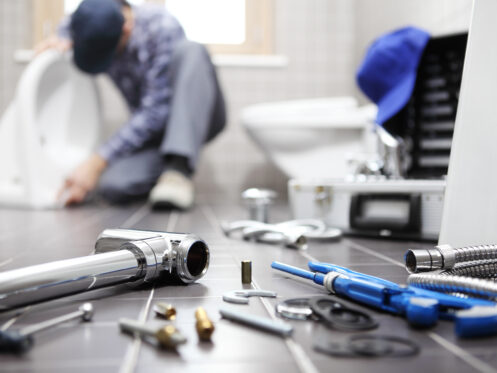The toilets in your home’s bathrooms are among its most essential plumbing fixtures. So, when they malfunction, it’s not something you can ignore for long. Many of the issues your toilets may develop will pertain to their flushing mechanisms. From ghost flushes to constantly running, you may experience various symptoms. The good news is that toilet flushing mechanisms are mechanically simple and easy to fix. Here’s everything you need to know to solve common toilet flushing mechanism problems.
Toilet Flushing Mechanism Basics
Before troubleshooting toilet flushing issues, you should understand how flushing mechanisms work. There are a few common flushing mechanism variants, but they all rely on the same basic principles. We’ll describe the most used flushing mechanism for simplicity’s sake.
When you look at your toilet’s front, all you see is its small flush handle. That handle connects to a long arm extending across your toilet tank’s inner front edge. Together, they form a lever that creates the mechanical force necessary to initiate a flush. Inside the tank, you’ll find a chain connecting the end of the flush arm to a rubber flapper in the tank base. The flapper has a bulbous protrusion on its bottom, which sits in the tank’s lower drain.
Upon pushing down on the flush handle, the lever raises the inner arm, pulling the flapper up. That allows the stored water in the tank to begin flowing out of the lower drain. From there, it flows into the bowl via small holes around the toilet’s rim. An additional hole in the bottom of the bowl creates siphon action to push waste down the drain.
Meanwhile, inside your toilet tank, the flapper’s buoyancy keeps it from closing the drain until the water level drops sufficiently. As that’s happening, your toilet tank’s fill mechanism gets to work. It consists of a lever-activated water valve and a float. As the water drains from the tank, the float drops, pulling down the valve arm and opening the valve. That starts the refill of the tank. As the water level rises, the float rises along with it. Once the water level climbs high enough, the float pushes the valve closed, stopping the water flow.
Repairing Common Flushing Mechanism Problems
The simplicity of the average flushing mechanism limits what can go wrong with it. As a result, you only need to know how to solve a small handful of common problems.
Loose Flush Handle
Your toilet’s flush handle can come loose after years of continuous use. If you press down on the handle and don’t meet near-instant resistance, that’s likely your problem. To fix it, begin by turning off your toilet’s water supply from its nearby valve. Then, flush your toilet. You can remove the tank’s lid and set it aside once the tank empties.
First, examine the chain connecting the flush arm and flapper with the lid removed. It should be taut, and the flush arm should be parallel to the top edge of the tank. If the arm is in the proper position and the chain seems loose, you can adjust the chain. If the arm is out of position, you can correct that while tightening the handle. To do so, you’ll need an adjustable wrench. You can use it to tighten the nut where the handle enters the tank.
Before you tighten the nut, rotate the flush handle and arm to bring them parallel with the tank edge. Then, using the wrench, turn the nut clockwise to tighten it. Go slowly and stop turning when you meet resistance. Overtightening the nut can crack your toilet tank’s porcelain. Double-check that the flapper chain remains taut when you finish tightening the nut. Then, you can replace the tank lid, turn the water supply back on, and test your toilet’s flush.
Trickling Water and Ghost Flushing
If you hear water trickling after your tank finishes refilling, your problem likely lies with your flapper. The sound you hear is water slowly leaking out of the tank and into the bowl. Eventually, when the problem gets worse, you may experience ghost flushing. That happens when the tank leaks enough to trigger the refill mechanism.
To fix the problem, turn off your toilet’s water supply, flush it, and remove the tank lid. Then, disconnect the chain from the flapper. That will let you remove the flapper by gently pulling it off its mounting pegs. Once you’ve removed the flapper, try cleaning and reinstalling it. Sometimes, hard water creates buildup on the flapper, preventing it from sealing the tank drain. If your toilet operates normally after reinstallation, you’ve solved the problem. If not, install a new compatible flapper to resolve your issue.
Constantly Running Toilet
If your toilet keeps filling endlessly after every flush, there’s a good chance the problem is its fill valve. Generally, the issue will come down to one of two causes. One is the fill valve’s float becoming stuck. You can remove your toilet tank lid and flush your toilet to check for this. If the float doesn’t move with the water level, try gently nudging it with your hand. Often, that’s enough to free up the float and restore normal functionality.
If the float moves freely but the valve doesn’t close, the valve itself is the likely culprit. There are typically two ways to solve the problem. The first is installing a new seal in your toilet’s fill valve. You can find the seal under the plastic cap covering the top of the fill valve. Again, turn off your toilet’s water supply and flush the toilet before attempting repairs. On most valves, you can access the seal by rotating the top of the valve counterclockwise. The seal looks like a black rubber disc. You can purchase a replacement at your local home improvement store. After fitting the new seal, put the valve cap back on and turn it clockwise to lock it in place.
You may need a new valve assembly if you can’t find a replacement seal or the repair doesn’t work. You can purchase a replacement kit that comes with detailed installation instructions. Remember, however, that you’ll need a bucket and some towels to prevent a mess as you replace the valve. Also, do not overtighten the nut that secures the valve stem to the tank bottom. As with the handle nut, you may damage your toilet that way.
The Plumber for Toilet Repair
Although you can fix most common flushing mechanism problems yourself, we recognize that not every homeowner wants to. Plus, there are many other toilet problems you should never try to fix on your own. Instead, you can call Fox Heating, Cooling & Plumbing for prompt toilet repair services. We’ve served Wheat Ridge homeowners for years, offering free estimates and quality workmanship. Plus, we have an A+ rating from the Better Business Bureau and countless five-star customer reviews. So, if you need a toilet repaired or a drain cleaned in your Wheat Ridge home, call Fox Heating, Cooling & Plumbing today!

